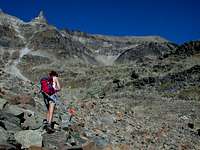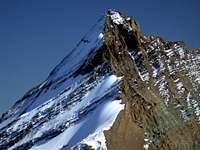-
 13751 Hits
13751 Hits
-
 86.37% Score
86.37% Score
-
 22 Votes
22 Votes
|
|
Mountain/Rock |
|---|---|
|
|
45.60320°N / 7.17290°E |
|
|
11200 ft / 3414 m |
|
|
Overview
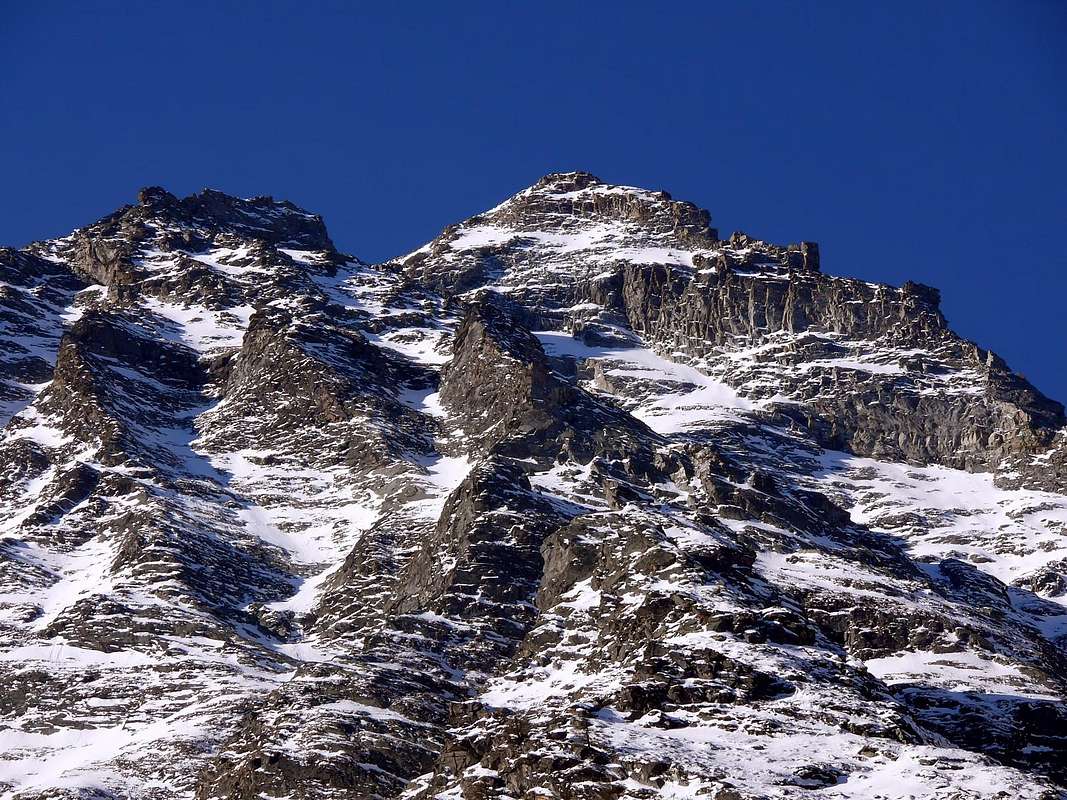
First Ascents
- First on the summit: Unknown.
- In winter: Unknown.
- South-southwest Ridge (to Tour de Notre Dame): Michele Baratono and Federico Chabod, September 01th, 1924, in descent from Punta Bioula.
- Southeast Slope (Normal Route): Unknown.
- West Wall: Leonardo Cossard and Remo Chabod, June 1938.
- Northwest Crest and West Face: Pier Francesco Quaini, lone, August 31th, 1914, in ascent from Western Bioula Basin.
- Northern Ridge: Lorenzo Rossi di Montelera with Guide Lindo Lucianaz, August 06th, 1976, in ascent from Rhêmes Creton and through Nequedé Pass.
- East-southeast Ridge: Osvaldo Cardellina, lone, September 24th, 1988, in ascent from Eaux Rousses and through Quotas 2.795, 3.125 meters.
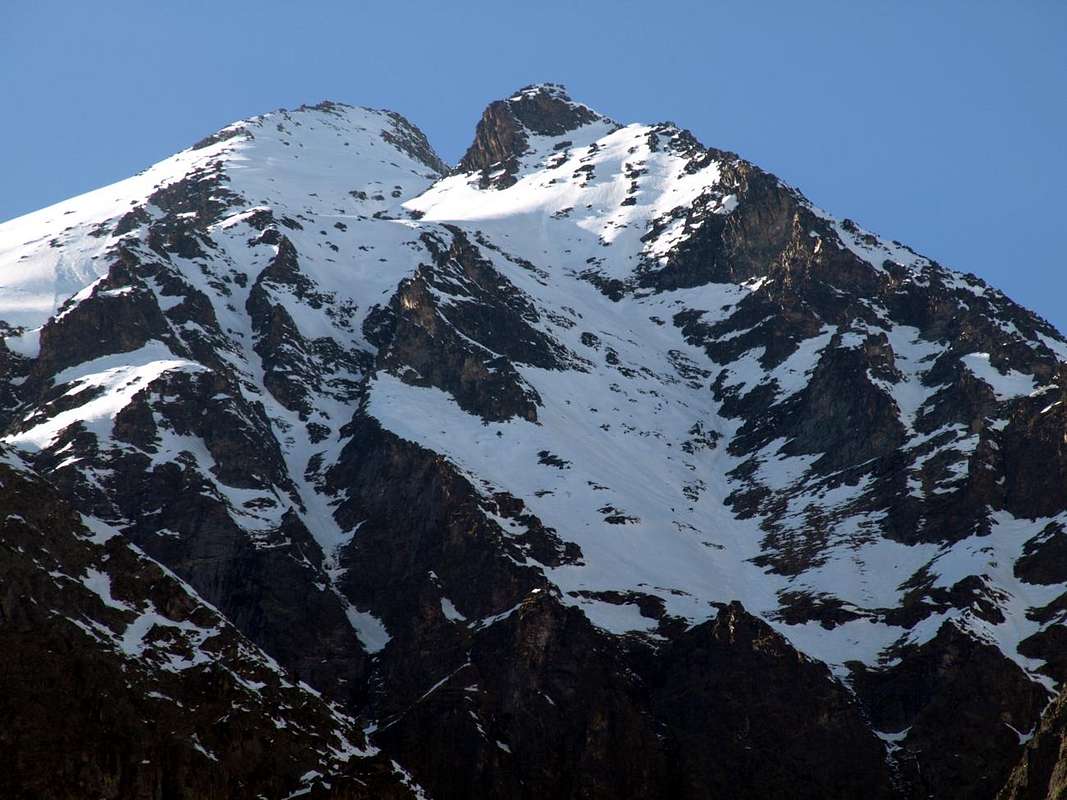
VARIOUS FIRST in ALL SUMMITS and GREAT TRAVERSES or CROSSINGS
- Tours de Notre Dame (3.355m): Michele Baratono and Federico Chabod, September 01th, 1924, from Lorguibet Pass (3.185m) and East Face. Integral ascent by Northern Ridge: Domenico Caresio, Damiano Gratton and Franco Perino; August 24th, 1968.
- Punta Bianca (3.440m): unknown or surely by Giovan Battista Bozzino, Summer 1911, from Djuan Basin by Eastern Crest.
- Clocher de Djuan (3.324m): Michele Baratono, Renato Chabod, Amilcare Crétier and Leonardo Pession, July 16th, 1926, with traverse to Punta Bianca. Second: Camillo Bianco, Emilio Micheli and Emilio Muller, August 1935; third: Osvaldo Cardellina, lone and secured from bottom by Giuseppe Lamazzi, August 18th, 1985.
- La Roletta (3.385m): unknown.
- First Crossing Bioula-Bianca-Clocher-La Roletta: Camillo Bianco, Emilio Micheli and Emilio Muller, August 1935.
- First Crossing Nequedé Pass-Bioula-Bianca-La Roletta: Lorenzo Rossi di Montelera and Lindo Lucianaz, August 06th, 1976.
- Integral Traverse (from Bioula-Tours de Notre Dame-Punta Bianca-Clocher de Djuan-La Roletta to Col de Sort): Osvaldo Cardellina and Giuseppe Lamazzi, August 18th, 1985.
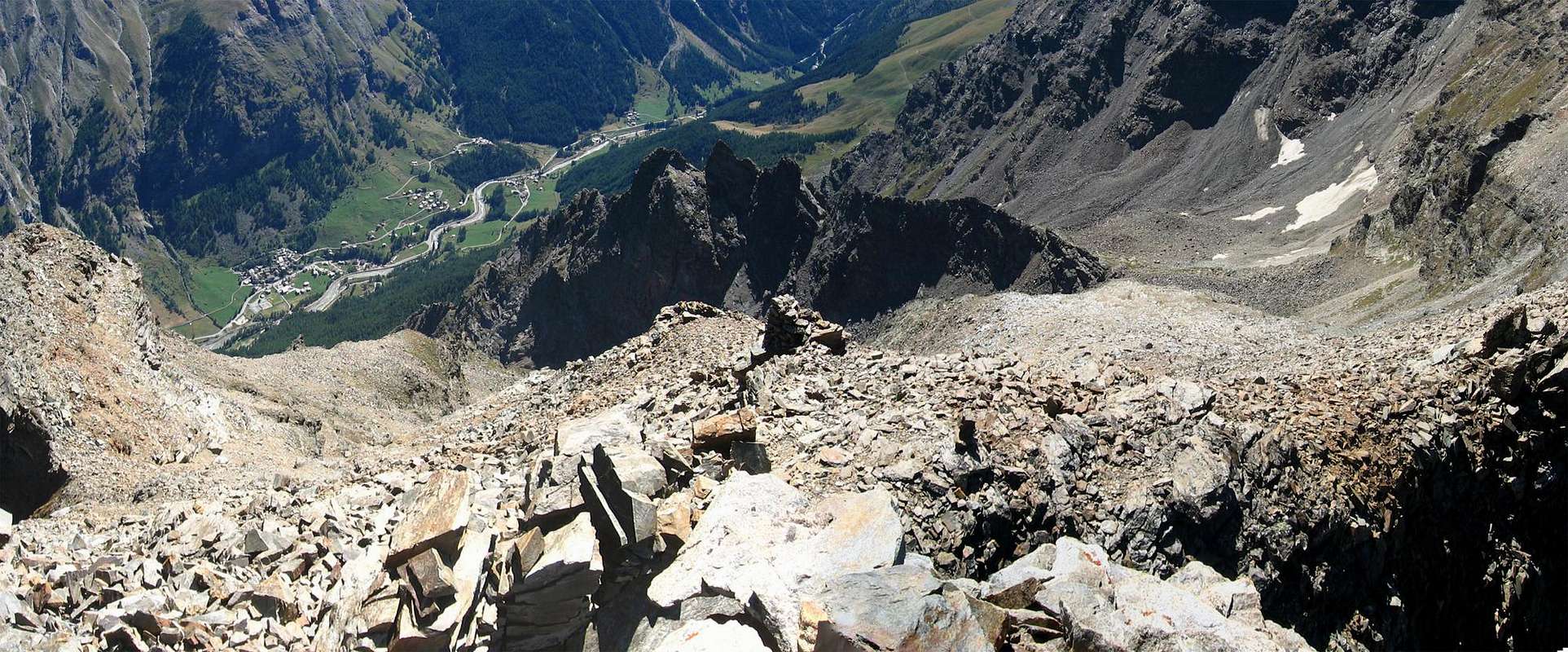
Getting There
- From Turin or Milan. Motorway A5. Get out at "Aosta Ovest". Follow Courmayeur direction. Once arrived in Villeneuve, turn for Introd. 2 km after Introd village, turn left for Valsavarenche. Park the car in Degioz: no tickets required. Water. Walk toward Vers Le Bois, crossing a paved bridge.
- From Martigny, Switzerland (Tunnel or Grand St. Bernard Pass) Follow Aosta direction, then Courmayeur. Arrived in Villeneuve, as previously described.
- From Chamonix (Tunnel Mont Blanc) or Bourg St. Maurice (Petit St. Bernard Pass), France. Follow Aosta direction. Before arriving in Villeneuve, turn right for Introd, then same as previous indications.
BY PLANE:
- Aeroporto "Corrado Gex" Saint Christophe (Aosta)
Route from Valsavarenche
Ancient ascent, followed by an old crossing "classic" between the two World Wars, but now fallen out of fashion. Remain the ascent to Bioula from Valsavara Slope and that of La Roletta from Rhêmes, while the climbing on crest is something reserved for the few. Dedicated to mountaineers lovers of old mountains and unusual itineraries. From Valsavarenche: by Degioz Chief town (1.541m) reach to the Southwest through the trail n° 8/8b the wide "Pavillon Royal de Chasse" (2.168m); from this, flexing with a diagonal route towards the Northwest with the large and evident mule track n° 8a easily reach, after bypassing a large saddle to the West respect of the characteristic Forquin Fourquin de bioula entering a small secondary vallon, the Summit of Bioula (EE/F; 4h'00/4h'30 from Degioz Village). The entire and integral traverse on ridge presents the passages with transition from the I°/II°/II°+ to the III°-/III°+ (Tour de Notre Dame, where you should maintain the same path both uphill and downhill) and of II°+/III°- for the Clocher de Djuan. The next North Ridge leading to Punta Bianca, formed by easy rocks, is not difficult as the following traverse to the Roletta, Clocher excluded; while the descent from La Roletta can be performed with return both in Valsavarenche and Rhêmes (A/PD/PD+; 2h'30/3h'00; from 7h'00 to 8h'00 in total).
Difficulty
F for the Punta Bioula; F+ to PD-/PD+ for the various ways described just above in First Ascents.
F per la Punta Bioula; dal F+ al PD-/PD+ per le varie vie descritte appena sopra in First Ascents.
Equipment
For Hiking or for Mountaineering, preferably with rope in relation to the route to be carried out.
Da Escursionismo o da Alpinismo, meglio se con corda in relazione all'itinerario da effettuarsi.
Red Tape
All this trek is inside Gran Paradiso National Parks. Campings (only over 2.500 mt for emergency reason is allowed, until dawn) and dogs are strictly forbidden. Other permits are not required.When To Climb
From July 'til September (in dry years even half October is good for).Camping
Remember that free camping is forbidden (except for emergency reasons, over 2.500m, from darkness until dawn).Mountain Condition
- You can get meteo information at the official site of the Regione Valle d'Aosta:
- Valle d'Aosta Meteo
- Meteo: You can find more weather information on the website 3B Meteo:
- Meteo Rhemes Notre Dame

Webcam
- WEBCAM on Aosta Valley:
- Webcam
Books and Maps
BOOKS:
- "Guida delle Alpi Occidentali", di Giovanni Bobba e Luigi Vaccarone C.A.I. Sezione di Torino Volume II (parte II), 25 Maggio 1896.
- "Guida dei Monti d'Italia-Gran Paradiso Parco Nazionale" E. Andreis, R. Chabod, M. C. Santis, Club Alpino Italiano/Touring Club Italiano, prima Ed. 1939; seconda Ed. 1963; terza Ed. 1980.
- "Gran Paradiso", G. Klotz, Ed. Bergverlag GmbH Rother, Monaco 2005 (in tedesco).
MAPS:
- Kompass "Gran Paradiso Valle d'Aosta Sentieri e Rifugi" Carta turistica 1:50.000.
- L'Escursionista Ed. Carta dei Sentieri "Valgrisenche/Val di Rhêmes" (carta n° 3) 1:25.000.
- Enrico Editore Ivrea-Aosta "Gruppo del Gran Paradiso" 1:50.000.
- I.G.C. Istituto Geografico Centrale, Torino "Il Parco Nazionale del Gran Paradiso" (carta n° 3) 1:50.000.
Important Information
- REGIONE AUTONOMA VALLE D'AOSTA the official site.
- FONDAZIONE MONTAGNA SICURA Villa Cameron, località Villard de la Palud n° 1 Courmayeur (AO) Tel: 39 0165 897602 - Fax: 39 0165 897647.
- SOCIETA' GUIDE ALPINE DEL GRAN PARADISO Comune di Valsavarenche.
- A.I.NE.VA. (Associazione Interregionale Neve e Valanghe).
Image by Buxlex
Useful phone numbers
- Protezione Civile Valdostana località Aeroporto n° 7/A Saint Christophe (Ao) Tel. 0165-238222.
- Bollettino Meteo (weather info) Tel. 0165-44113.
- Unità Operativa di Soccorso Sanitario Tel. 118.






















